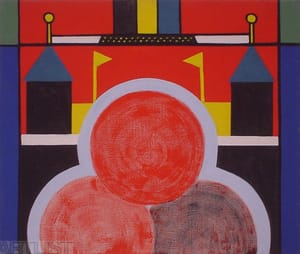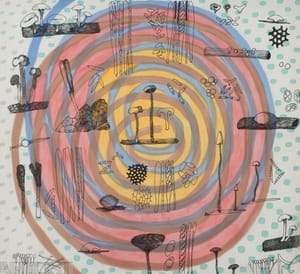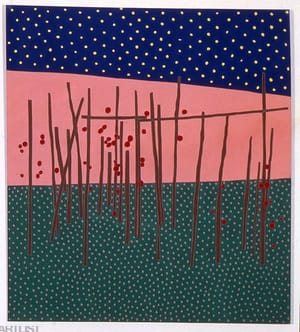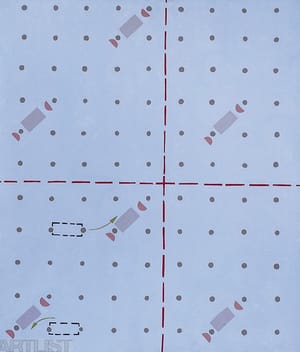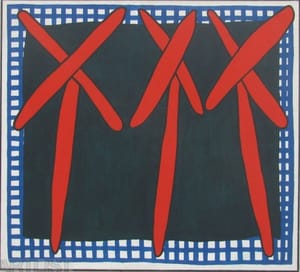- First Name
- Stanislav
- Surname
- Diviš
- Born
- 1953
- Birth place
- Kutná Hora
- Place of work
- Praze
- i-datum
- ↳ Find in the VVP AVU database
- Keywords
- CSU Library
- ↳ Find in the catalogue
About artist
Stanislav Diviš was born on 20 November 1953 in Kutná Hora and was attracted to the world of fine art when he fell in love with the work of František Kupka. It is interesting that at junior school in Telč his marks in art were only average. After studying to be an electrician and passing his baccalaureate at senior school in Kutná Hora, between 1975 and 1982 he worked as a labourer in many different jobs and made several attempts to be accepted by an art school. In 1982, he finally won a place at the Academy of Fine Arts (AVU) in the restoration department. In 1983 and 1984 he had already organised his first events, which heralded the later and extremely important Confrontations. These were St Nicholas parties held at AVU, for which students from all the studies created the decorations. From 1984 to 1987 along with Jiří David he organised a total of six of these illegal and semi legal Confrontations, which represented for students at that time the only possibility of freely exhibiting their work. In 1985, under the pretext of transferring to the Academy of Arts, Architecture and Design, he was obliged to terminate his studies and since 1987 has been regularly showing his works at all important Czech and foreign contemporary art exhibitions. Also in 1987 the Tvrdohlaví group was formed, and Diviš was part of its first joint exhibition in December of that year. In 1996 and 1997 he worked as assistant to Jiří David in the latter’s studio in AVU, and from 2003 was head of the painting studio at the Academy of Arts, Architecture and Design, a position he left in 2010.
Since midway through the 1990s Stanislav Diviš’s works have occupied a space more or less on the boundary of abstraction, but almost always with a residue of materiality through the use of alternative symbols. During this period, semiotics, especially in Diviš’s and David’s pictures, became a symbol of Czech postmodernism and Diviš’s pictures always exercise our imagination and the power of symbols. Another feature characterising his work is the fact it almost always involves extensive cycles, which are marked by concentrated formal and expressive integrity and the constant reinterpretation of the artist’s own older works or the models of other artists.
His first large cycle entitled Clowns, which the artist worked on in 1984 and 1985, is understandably strongly influenced by the neo-expressionist wave of the German Neue Wilde and the Italian trans-avantgarde. Around 1987, Diviš painted canvases with an exclusively sacred theme. These include the Twelve Apostles, Golgotha, Ark and Carrying the Cross, which were exhibited as a complete cycle at Diviš’s first solo exhibition in the Blatiny Cultural Centre, Prague, and which feature a more or less strict lattice-like grid. In 1990, he created the cycle entitled Spartakiada 90, in which he depicted the movements of the gymnasts on the surface of the stadium using field coordinates. A later reminiscence of this cycle is his set of pictures entitled Recollection of Spartakiada 90. In Scores (1992) he attempted, like many of his predecessors who had been Czech composers of musicals or Orphists, to transpose musical notation into an ingenious system of symbols as abstract as music itself. The cycle entitled Remains, which dates back to 1995, was inspired by samples of materials produced today by the now desolate West Bohemia textile works in Aš, and addresses the question of the search for possible barriers to the deconstruction of the model. The cycle Mushrooms (1995) confronts the abstract coloured surface of the background with exact transcriptions of drawings from a mycological atlas. The starting point of the cycle Two Worlds (2002 – 2003) were the drawings created by Diviš’s son when still a boy.
- Author of the annotation
- Jakub Král
- Published
- 2012
CV
Studies:
1982-1985 Academy of Fine Arts in Prague
Employment:
2002-present teaches painting at the Academy of applied arts, architecture and design Prague
- Member of art groups included in ARTLIST.
Exhibitions
- Solo exhibitions
-
2012
Jiří David, Stanislav Diviš, … probatum est, Galerie Miroslava Kubíka, Litomyšl, CZ
2011
Střepy, zbytky, doteky, Galerie moderního umění v Hradci Králové, Hradec králové, CZ
2010
Stanislav Diviš, Wannieck Gallery, Brno, CZ
2009
Ztracené světy, Galerie města Plzně, Plzeň, CZ
2006
Květy z ráje, Galerie České pojišťovny, Praha, CZ
2005
Retrospektiva, Východočeská galerie Pardubice, Pardubice, CZ
Retrospektiva, Galerie U Bílého jednorožce, Klatovy, CZ
2004
Dva světy, Květy z ráje, Národní galerie v Praze, Praha, CZ
2003
Dva světy, Galerie ad astra, Kuřim, CZ
2001
Dva světy, Obrazy, Galerie Felixe Jeneweina města Kutné Hory, CZ
2000
Katedrála, Galerie V Kapli, Bruntál, CZ
1998
Diviš Vidíš…, Galerie MXM, Praha, CZ
1997
Stanislav Diviš, Galerie Sokolská 26, Ostrava, CZ
1996
Zbytky, Galerie MXM, Praha, CZ
1995
Zbytky, Galerie Caesar, Olomouc, CZ
Partitury a Zbytky, Židovský hřbitov, márnice, Třebíč, CZ
Stanislav Diviš, Galerie MXM, Praha, CZ
1993
Obrazy 1985 – 1992, Galerie Václava Špály, Praha, CZ
Stanislav Diviš, Galerie MXM, Praha, CZ
1991
Stanislav Diviš, Galerie MXM, Praha, CZ
1988
První světová výstava vědeckého realismu, Galerie Opatov, Praha, CZ
Obrazy, Galerie mladých, Brno, CZ
Obrazy, Kulturní středisko Blatiny, Praha, CZ
- Group exhibitions not included in ARTLIST.
-
2012
Ostrovy odporu, Mezi první a druhou moderností, Národní galerie v Praze, Praha, CZ
2011
PBBK80, Galerie NTK, Praha, CZ
2010
1984 – 1995, Česká malba generace 80. let, Wannieck Gallery, Brno, Cz
2009
Po Sametu: Současné české umění s přesahy do minulosti, Galerie hlavního města Prahy, Praha, CZ
2008
Tvrdohlaví po 20 letech, České muzeum výtvarného umění, Praha, CZ
2007
Tvrdohlaví po 20 letech, Galerie výtvarného umění v Ostravě, Ostrava, CZ
Kacíř & spol.: zlaté město, Galerie Jiří Švestka, Praha, Cz
2006
Co se děje? Přírůstky Východočeské galerie z let 1993-2006, Východočeská galerie v Pardubicích, Pardubice, CZ
Kacíř & spol.: Montáže na ose Brno Berlín, Dům umění města Brna, Brno, CZ
+ - 50: Generace 80. let ze sbírek Galerie Klatovy / Klenová, Galerie U Bílého jednorožce, Klatovy, CZ
2005
Druhý dotek, Dům umění města Brna, Brno, CZ
Nové přírůstky sbírek Galerie Felixe Jeneweina města Kutné Hory z let 1996-2004, Galerie výtvarného umění v Ostravě, Ostrava, CZ
2003
Umělecká skupina Tvrdohlaví, Galerie Františka Drtikola, Příbram, CZ
281 m², Galerie Václava Špály, Praha, CZ
Tvrdohlaví V., Galerie Tvrdohlaví, Praha, CZ
2002
Na papíře, Galerie MXM, Praha, CZ
2001
První a poslední, Galerie Václava Špály, Praha, CZ
2000
Současná minulost: Česká postmoderní moderna 1960-2000, Alšova jihočeská galerie v Hluboké nad Sázavou, Hluboká nad Vltavou, CZ
1999
4. výstava výtvarné skupiny Tvrdohlaví, Valdštejnská jízdárna, Praha, CZ
1998
Tak daleko, tak blízko, Galerie MXM, Praha, CZ
1997
Mezi tradicí a experimentem. Práce na papíře a s papírem v českém výtvarném umění 1939-1989, Muzeum moderního umění, Olomouc, CZ
1996
Česká abstraHce, Galerie Václava Špály, Praha, CZ
Mrkačka, Galerie MXM, Praha, CZ
1995
Starozákonní motivy v českém umění dvacátého století, Galerie umění Karlovy Vary, Karlovy Vary, CZ
Starozákonní motivy v českém umění dvacátého století, Galerie moderního umění v Roudnici nad Labem, Roudnice nad Labem, CZ
Zkušební provoz / Test Run, Mánes, Praha, CZ
1993
Záznam nejrozmanitějších faktorů…, České malířství 2. poloviny 20. století ze sbírek státních galerií, Jízdárna Pražského hradu, Praha, CZ
1991
3. výstava Umělecké skupiny Tvrdohlaví, Galerie hlavního města Prahy, Praha, CZ
1990
Jiří David, Stanislav Diviš, Vladimír Kokolia, Výstavní síň Malovaný dům, Třebíč, CZ
Pocta umělců Jindřichovi Chalupeckému, Galerie hlavního města Prahy, Praha, CZ
1989
2. výstava Umělecké skupiny Tvrdohlaví, Výstavní síň Ústředí lidové a umělecké výroby, Praha, CZ
Tvrdohlaví, Výstavní síň Viléma Wünscheho, Havířov, CZ
Mladí Janu Bauchovi, Galerie Václava Špály, Praha, CZ
Tschechische Malerei heute, Galerie der Stadt Esslingen, Esslingen am Neckar, D
1987
Tvrdohlaví, Lidový dům, Praha, CZ
Konfrontace VI, Špitálská ulice, Praha, CZ
1986
Konfrontace V, Statek Milana Periče, Svárov, CZ
Mladí pražští výtvarníci, Galerie Na bidýlku, Brno, CZ
Konfrontace IV, Mozartova 7, Praha, CZ
1985
Konfrontace III, Dům Magdaleny Rajnišové, Kladno, CZ
1984
Konfrontace II, Krymská 21, Praha, CZ
Konfrontace I, Ateliér Jiřího Davida, Praha, CZ
- Collections
-
Národní galerie v Praze
Galerie hlavního města Prahy
Galerie Benedikta Rejta v Lounech
Východočeská galerie Pardubice
Galerie Felixe Jeneweina města Kutné Hory
Wannieck Gallery
soukromé sbírky v České republice, Slovensku, Rakousku, Německu, Švýcarsku, Španělsku, USA, Japonsku
Monography
- Monography
2012
Martin Dostál, Jiří David, Stanislav Diniš, … probatum est, Praha, 2012.
2011
Stanislav Diviš, Střepy, zbytky, doteky, Galerie moderního umění v Hradci Králové, 2011.
2009
Stanislav Diviš, Ztracené světy (kat. výst.), Galerie města Plzně, 2009.
2008
Martin Dostál, Stanislav Diviš, Praha, 2008.
2006
Stanislav Diviš, Květy z ráje (kat. výst.), Galerie České pojišťovny, 2006.
2001
Stanislav Diviš, Dva světy, Obrazy (kat. výst.), Galerie Felixe Jeneweina města Kutné Hory, 2001.
1993
Stanislav Diviš, Obrazy 1985 – 1992 (kat. výst.), Galerie Václava Špály, 1993.
- Articles
Martin Dostál, Stanislav Diviš, Detail V, 1998, č. 3, s. 3.
Jana Ševčíková, Jiří Ševčík, Paradoxy nejen Stanislava Diviše, Výtvarné umění, 1992, č. 3, s. 34-39.
Jiří Olič, Tvrdohlaví 1987 – 1990, Výtvarné umění, 1991, č. 1, s. 41-44.
Pavel Ondračka, II. výstava Tvrdohlavých, Výtvarná kultura, 1990, č. 3, s. 37-40.





